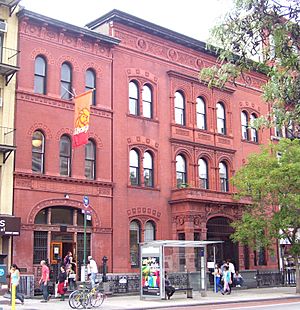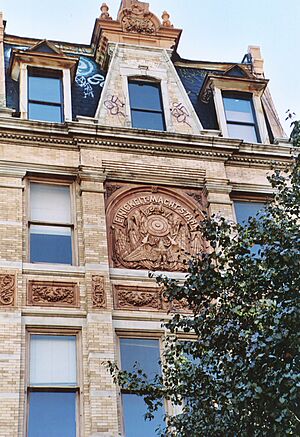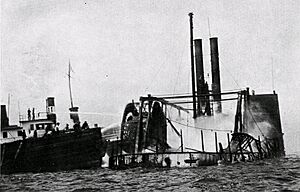Little Germany, Manhattan facts for kids

Little Germany, also known by its German names Kleindeutschland or Deutschländle, was a lively neighborhood in New York City. It was located in the Lower East Side and East Village areas of Manhattan. This part of the city was home to many German immigrants. People who were not German often called it "Dutchtown."
The neighborhood began to change in the late 1800s. More and more non-German immigrants started moving into the area. The number of German residents slowly went down. This change sped up in 1904 because of a terrible event. A ship called the General Slocum sank, and over 1,000 lives were lost. This disaster greatly affected the German community.
How Little Germany Grew
Starting in the 1840s, many German immigrants came to the United States. This brought a steady flow of people to Little Germany. In the 1850s alone, about 800,000 Germans arrived in New York. By 1855, New York City had the third largest German population in the world. Only Berlin and Vienna had more German residents.
German immigrants were often different from other groups. They usually had good education and useful skills. Many were bakers or cabinet makers. A lot of Germans also worked in construction. Educated Germans like Joseph Wedemeyer, Oswald Ottendorfer, and Friedrich Sorge helped create and grow trade unions. Many Germans and their clubs, called Vereine, were also active in politics.
Oswald Ottendorfer owned the Staats-Zeitung. This was New York's biggest German-language newspaper. He was one of the richest and most important German-Americans in the city. He also became a leader in German politics. He helped Fernando Wood become mayor in 1861 and Godfrey Gunther in 1863.
Germans often preferred to live close to each other. People from specific German states even liked to live together. For example, people from Prussia mostly lived in the Tenth Ward. Those from Hessen-Nassau lived in the Thirteenth Ward. Later, they moved north. People from Baden often chose the Thirteenth Ward.
The Bavarians were the largest group of German immigrants by 1860. They were found in most German areas. However, they tended to avoid places where many Prussians lived. A small group from Hanover even formed their own "Little Hanover" in the Thirteenth Ward.
By 1845, Little Germany was already the biggest German-American neighborhood in New York. By 1855, its German population had grown more than four times. At the start of the 1900s, almost 50,000 people lived there. The neighborhood grew from the 11th Ward to include most of the 10th, 13th, and 17th Wards. This is the same area that later became known as the Jewish Lower East Side.
Tompkins Square Park was an important public space. Germans called it the Weisse Garten, meaning "White Garden." The neighborhood had many places for the community. There were beer gardens, sports clubs, libraries, choirs, and shooting clubs. There were also German theaters, schools, churches, and synagogues. Many factories and small workshops were in the area. Major shopping streets with department stores also served the community.
The General Slocum Disaster
On June 15, 1904, St Mark's Evangelical Lutheran Church held its 17th yearly picnic. It was to celebrate the end of the school year. A large ship called the General Slocum was rented for a trip on the East River. The plan was to go to a picnic spot on Long Island. Over 1,300 people, mostly women and children, were on board.
Soon after the ship left, a fire started in a storage area. The ship had lifeboats and life preservers, but they were old and not working well. The safety equipment was not good enough. Also, Captain William Van Schaick did not manage the situation well. Because of this, about 1,021 passengers died from the fire or by drowning.
Only a small part of Little Germany's population was lost in the disaster. However, those who died were often members of the oldest and most important families. They were the heart of the community. The huge loss had a big impact on the St Mark's church and the whole neighborhood. The disaster, along with people already moving away, and later anti-German feelings during World War I, led to the end of Kleindeutschland.
People wanted to find someone to blame for the tragedy. This, along with disagreements among survivors about money from a relief fund, made the community's spirit turn sour. Captain Van Schaick was punished for not having proper safety equipment. He received a ten-year prison sentence.
Decline of Little Germany
The General Slocum disaster was a major event that sped up the end of Little Germany. But the neighborhood had been getting smaller for decades before that. By the late 1800s, between 1870 and 1900, many second-generation German-Americans started to leave. They moved to Brooklyn, especially to Williamsburg, and to other parts of Manhattan like Yorkville.
At the same time, many new immigrants arrived in the city. These included more Germans (though their numbers peaked in the 1880s), Irish people, and large groups of Russian and Eastern European Jews, and Italians. This made Little Germany shrink. It used to cover a large part of the East Side below 23rd Street. Eventually, its borders became 14th Street to the north, Grand Street to the south, Broadway to the west, and the East River to the east.
The arrival of these new immigrant groups changed the area's character. What was once Kleindeutschland slowly became known as the Lower East Side. The Slocum disaster made this process happen even faster. After the tragedy, many of the remaining German residents moved away, often to Yorkville or other places.
See also
 In Spanish: Little Germany (Manhattan) para niños
In Spanish: Little Germany (Manhattan) para niños




